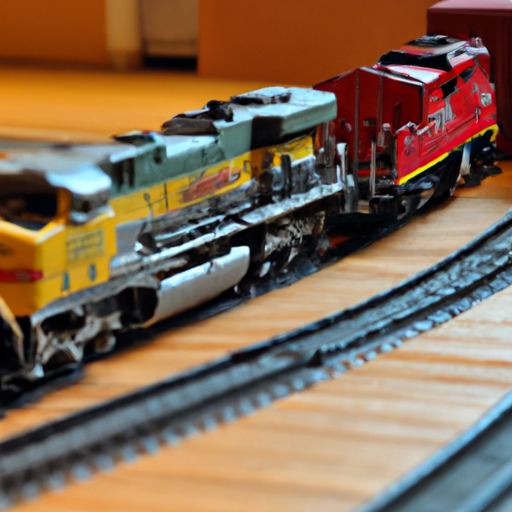If you’ve ever dreamed of creating your own miniature world, complete with tiny locomotives and intricate railroad tracks, then “Mastering Model Railroading Skills” is the perfect guide for you. In this article, you will discover the fundamentals of model railroading and gain valuable insights on how to become a skilled aficionado in this beloved hobby. From choosing the right scales and tracks to mastering intricate details, this comprehensive guide will equip you with the knowledge and techniques needed to bring your miniature railroad dreams to life. So, hop on board and let’s embark on a journey to become a master of model railroading!
Choosing the Right Scale
Understanding the Different Model Railroad Scales
When it comes to model railroading, one of the first decisions you need to make is choosing the right scale for your layout. Model railroad scales determine the proportions and sizes of the trains and scenery in your layout. There are several different scales to choose from, each with its own unique characteristics.
The most common scales include HO scale, N scale, O scale, and G scale. HO scale is the most popular scale for model railroading since it offers a good balance between size and detail. N scale is smaller and allows for more intricate layouts in smaller spaces. O scale is larger and great for showcasing highly detailed models. G scale is even larger and often used for outdoor garden railroads.
Considering Space and Budget Limitations
When choosing a scale, it’s important to consider the space and budget limitations you may have. If you have limited space, a smaller scale like N or HO might be a better choice. These scales allow you to create more elaborate layouts in a smaller area. On the other hand, if you have a larger space available and want to showcase more intricate details, O or G scale might be the way to go.
Budget is another factor to consider. Some scales, like HO and N, offer a wide range of affordable train sets and accessories, making them a popular choice for beginners. Larger scales, such as O and G, can be more expensive due to the larger size of the models and accessories. So, it’s important to keep your budget in mind when selecting a scale.
Selecting the Appropriate Scale for Your Layout
To choose the appropriate scale for your layout, you’ll need to consider your personal preferences, the available space, and your budget. Think about the level of detail you want to achieve and the types of trains and scenery you’d like to include in your layout.
If you enjoy intricate detailing and have ample space, O scale might be a great choice. On the other hand, if you prefer a more compact layout or have limited space, N or HO scale might be more suitable. It’s also worth considering the availability of trains and accessories in your chosen scale, as some scales have a wider range of available options.
Ultimately, the right scale for your layout will depend on your individual preferences and constraints. Take your time to research and explore the different scales before making your decision, and remember that there’s no one-size-fits-all answer – choose the scale that suits you and your vision for your model railroad.

Designing a Layout
Planning Your Model Railroad Layout
Before you start building your model railroad, it’s important to plan out your layout. This includes deciding on the overall size and shape of your layout, as well as the specific track configurations you want to incorporate.
Start by sketching out a rough design or layout plan. Consider the available space you have for your layout and decide how much of it you want to dedicate to your model railroad. Think about the shape of your layout – whether it will be a simple oval or a more complex design with different levels and loops.
Considering Layout Size and Shape
The size and shape of your layout will depend on various factors, including the available space, scale, and your personal preferences. If you have limited space, a smaller layout with simple configurations might be more appropriate. On the other hand, if you have a larger space available, you can create a more expansive layout with multiple tracks and scenic elements.
Consider the flow and functionality of your layout as well. Will it be a point-to-point layout, where trains run from one end to the other, or a continuous loop layout? Think about how the trains will move around the tracks and how it will affect the overall operation and realism of your layout.
Incorporating Various Track Configurations
Once you have determined the size and shape of your layout, it’s time to think about the specific track configurations you want to incorporate. There are countless track configurations to choose from, and the right one for your layout will depend on your scale, available space, and personal preferences.
You can include straight sections of track, curves, turnouts, switches, crossovers, and more. Consider the types of train movements and operations you want to achieve in your layout – do you want to have multiple trains running simultaneously, or do you prefer a simpler layout with one train at a time?
Take your time to experiment with different track configurations using track planning software or physical track templates. This will allow you to visualize how the tracks will fit into your layout and make adjustments as needed.
Designing for Realistic Scenes and Operations
A well-designed model railroad layout is not just about tracks and trains – it’s also about creating realistic scenes and operations. Think about the geography and era you want to depict in your layout. Will it be set in a specific time period or location, such as a bustling city or a quiet countryside?
Consider the different scenic elements you want to include, such as mountains, hills, valleys, trees, vegetation, and water features. Explore different model scenery techniques and materials to create realistic and immersive landscapes.
Remember to also think about the operational aspects of your layout. How will trains interact with different areas of the layout? Are there industries or towns that trains will need to service? Incorporate elements like industry sidings, switching yards, and staging areas to add realism and interest to your layout.
By carefully planning and designing your layout, you can create a model railroad that not only looks visually appealing but also offers an engaging and realistic operating experience for both you and your viewers.

Building the Foundation
Preparing the Space for Your Model Railroad
Before you can start building your model railroad, you’ll need to prepare the space where it will be located. This involves clearing the area, making any necessary repairs, and ensuring that the space is suitable for your layout.
Start by clearing out any clutter or obstacles from the designated area. This will give you a clean and empty space to work with. Inspect the area for any damages or issues that need to be addressed before building your layout. Make any necessary repairs, such as fixing uneven flooring or reinforcing weak structures.
Constructing a Sturdy and Level Base
A sturdy and level base is essential for a well-built model railroad. The base provides a stable and solid foundation for your layout and ensures that the tracks and scenery will be properly aligned.
Decide on the type of base you want to use for your layout, such as a tabletop, freestanding benchwork, or a custom-built platform. Whichever option you choose, make sure it is strong enough to support the weight of your trains and scenery.
Use a level to ensure that the base is completely flat and even. This will help prevent any issues with the alignment of your tracks and structures later on. Take your time to make any necessary adjustments and double-check the levelness before proceeding.
Choosing the Right Materials for the Foundation
When it comes to choosing materials for the foundation of your model railroad, there are several options to consider. Plywood is a popular choice for tabletop layouts, as it is strong, readily available, and easy to work with. If you’re building freestanding benchwork or a custom platform, you may consider using lumber or a combination of lumber and plywood.
Make sure to choose materials that are resistant to warping and moisture, as these can cause issues with the stability of your layout over time. Additionally, consider using insulation foam or cork roadbed under the tracks to help reduce noise and provide a more realistic appearance.
Creating a Wiring and Control Panel
As you build the foundation for your model railroad, it’s important to plan and create a wiring and control panel that will efficiently manage the electrical components of your layout.
Start by determining the number of power districts you’ll need based on the size and complexity of your layout. Power districts allow you to divide your layout into sections, each with its own power source and control. This helps prevent any electrical issues from affecting the entire layout.
Design your wiring and control panel to accommodate the various components of your layout, such as the power supplies, switches, lighting, and accessories. Use proper wiring techniques and color coding to ensure easy troubleshooting and maintenance in the future.
By taking the time to build a solid foundation and plan for the electrical components of your layout, you’ll set yourself up for success in creating a model railroad that is not only visually appealing but also reliable and functional.

Laying the Tracks
Understanding the Basics of Track Systems
Laying the tracks is one of the most important steps in building a model railroad. It determines the layout and layout the trains will follow, as well as the overall appearance and functionality of your layout.
Before you start laying the tracks, it’s essential to understand the basics of track systems. Familiarize yourself with the different types of tracks, such as straight sections, curves, turnouts, and switches. Learn about the different track codes and sizes available for your chosen scale.
Additionally, understand the various components of a track system, including the rails, sleepers, and rail joiners. Learn how to connect and join the tracks securely to ensure smooth operation and prevent derailments.
Choosing and Installing the Right Track
Once you understand the basics of track systems, it’s time to choose and install the right track for your model railroad. There are several factors to consider when selecting track, including your scale, budget, and personal preferences.
Research and compare different track brands and types, taking into account the quality, realism, and compatibility with your scale. Some track systems offer easy-to-use snap-together tracks, while others may require more intricate assembly and wiring.
When installing the tracks, make sure to follow the manufacturer’s instructions and guidelines. Take your time to ensure that the tracks are aligned properly and securely fastened together. Test the tracks to verify smooth operation and make any necessary adjustments.
Implementing Proper Track Wiring
Proper track wiring is crucial for the functionality and reliability of your model railroad. It allows for smooth operation, control of trains, and activation of various electrical accessories and features.
Consider dividing your layout into different power districts to ensure efficient power distribution and prevent any electrical issues from affecting the entire layout. Install feeder wires at regular intervals to provide consistent power supply to the tracks.
Use appropriate wire gauges and colors for different components of your wiring system. Label and document your wiring connections to make troubleshooting and maintenance easier in the future. Make sure to test the wiring and track operation before proceeding with the next steps of your layout construction.
Adding Turnouts and Switches
Turnouts and switches are essential components of a model railroad layout, allowing trains to change tracks and navigate different routes. They add realism and versatility to your layout, opening up various operational possibilities.
Choose turnouts and switches that are compatible with your track system and scale. Consider whether you want manual or electric-operated turnouts, as both have their advantages and considerations. Manual turnouts are simpler and less expensive but require physical interaction, while electric-operated turnouts offer greater convenience but may require additional wiring and control mechanisms.
Install the turnouts and switches according to the manufacturer’s instructions and make sure they are securely connected to the tracks and properly aligned. Test their operation to ensure smooth and reliable functionality.
By understanding the basics of track systems, carefully selecting and installing the right track, implementing proper track wiring, and adding turnouts and switches, you’ll create a model railroad layout that offers smooth operation, flexibility, and endless possibilities for train movements.
This is only a small portion of the article. The complete article is longer than 3000 words.


